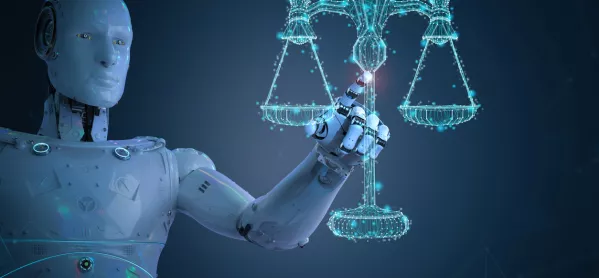- Home
- ‘AI in UK schools? I’d give us 5 out of 10’
‘AI in UK schools? I’d give us 5 out of 10’

On a visit to China this summer, I was asked by a local journalist if I thought their country’s education and training system was ready for artificial intelligence (AI) and the fourth industrial revolution (4IR).
This got me thinking about what it means for any country - let’s say the UK - to be AI-ready in educational terms.
In this country, there is increasing discussion and debate around the use of technology, including AI, in teaching and learning. Most teachers know the technology exists, but perhaps not necessarily how it can help them in their everyday work.
Need to know: What is the fourth industrial revolution?
Opinion: ‘This is the fourth industrial revolution - we need a new curriculum for tomorrow’s world’
Analysis: ‘Let the robots mark and the teachers teach’
AI is here to stay
It’s an ongoing conversation, which will pick up pace in the coming years. It must because AI is already here, and it’s not going away.
Observing how other countries have prepared themselves for the AI revolution serves as a useful gauge of where we are in the UK.
Returning to the question of China, the government there has invested billions of yuan in technical infrastructure - including AI - particularly in its universities, to strengthen basic AI knowledge and to boost research and innovation.
China has been reforming its education system for several years now, focusing on creating an assessment system for national basic educational quality, which includes academic achievements but also practical and innovative capability, science and humanities, literacy, morality, physical health and mental health. It is also developing a data and technology infrastructure to support the evaluation of these areas, which will include real-time monitoring of teaching and learning, plus the tracking of thousands of schools across hundreds of counties.
Crucially, Chinese policymakers see information technology, including AI, as a way of reducing the attainment gaps between schools in rural and urban areas. Their aim is to provide rural populations with the most sophisticated technology, which, given the good internet connectivity across the country, makes a great deal of sense. The country is also investing in a significant programme of teacher training, to upskill practitioners for the 4IR.
Integrated education ecosystem
Another good example of innovation, closer to home, is Estonia, where AI is seen as a creator of new value. The Estonian Education and Research Strategy 2021-2035, published earlier this year, advocates reform of the education system summarised through a set of goals, including building learning environments that combine school, vocational, cultural and adult education with the workplace. This integrated education ecosystem will also involve businesses, civic organisations and parents, with everyone working together to develop individual learning paths for all learners.
Another goal is a redesign of the curriculum for general education from preschool onwards. The emphasis will be on self-directed learning, and the introduction of more collaborative and problem-based learning methods.
As a result, teacher training is scheduled for reform, with a focus on training teachers to guide the learner-centred individualised learning process, and to develop learners’ self-management skills.
National AI education
And so back to the UK. We are certainly investing in trying to ensure that every area in the country is broadband-connected to the internet reliably, but we are not quite there yet. We recognise the importance of investing in AI expertise at university level, and we also have a national retraining scheme to address the needs of the workforce.
I have not seen a great deal of attention to interagency working, as is happening elsewhere, or to integration across educational sectors.
Nor have I seen any educational reforms that target the needs of the 4IR, or recognition of the need to invest in AI for education, although we do have an AI sector deal for AI companies.
As far as I am aware, there is no national programme to educate the population about AI either, which is much needed if we are to tackle some of the myths about the technology.
What we do have is an exciting and innovative start-up ecosystem, with many educational-technology and AI ventures taking shape. Computer science is taught in schools, although neither that nor coding is the same as teaching about AI, and unfortunately students are switching off the GCSE in significant numbers.
Taking all this into consideration, I would give us 5/10, whereas Estonia and China must be at least 8/10 and pushing for 9/10. The phrase “could do better” springs to my teacher mind here.
So what can we do? We need to gather our energy to persuade policymakers that we do need investment in educational reform. We need greater investment in - and a transformation of - teacher training, if we are to start catching up with our international counterparts and competitors.
Rose Luckin is professor of learner-centred design at UCL Knowledge Lab, and director of the UCL EDUCATE programme. She tweets as @Knowldgillusion
Keep reading for just £1 per month
You've reached your limit of free articles this month. Subscribe for £1 per month for three months and get:
- Unlimited access to all Tes magazine content
- Exclusive subscriber-only stories
- Award-winning email newsletters



